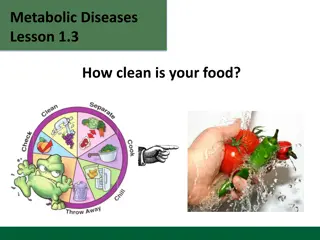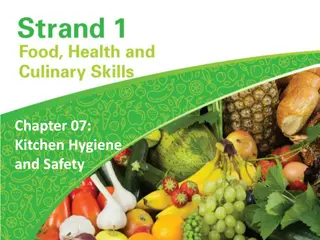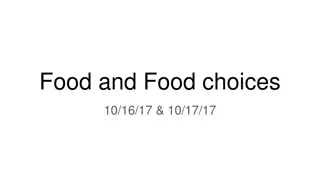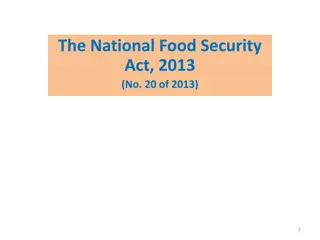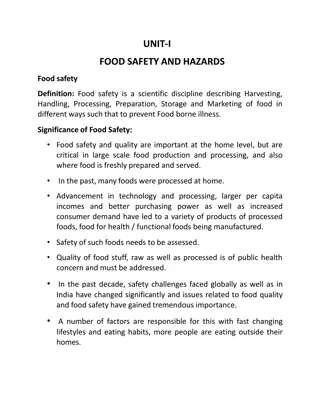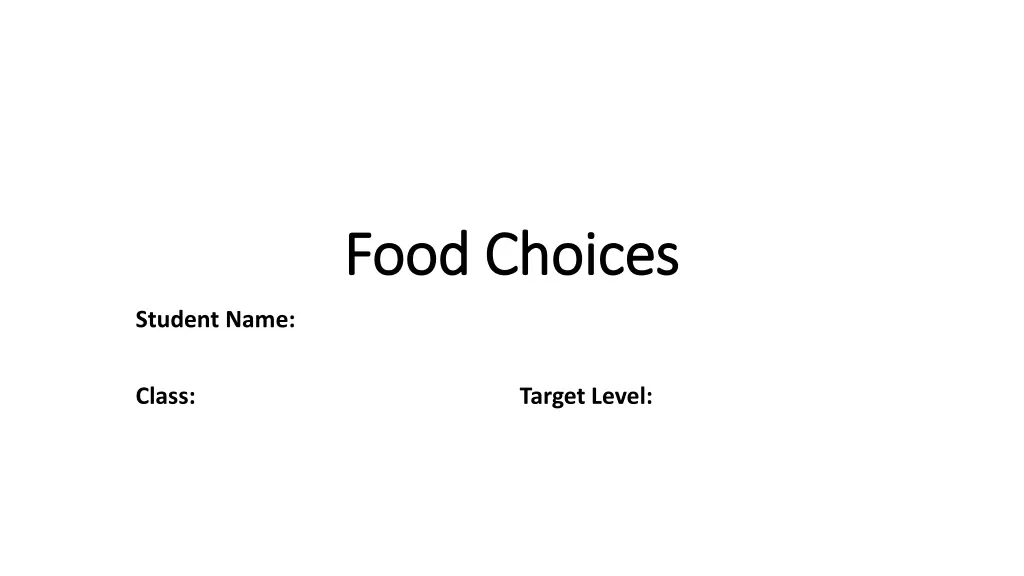
Exploring Food Choices and Cultural Influences
Discover the diverse world of food choices, from traditional British cuisine to modern multicultural influences. Delve into the factors affecting food choices and learn about different regional and international dishes. Explore the impact of various religions on dietary practices and get insights into planning a buffet menu with sustainability in mind.
Download Presentation

Please find below an Image/Link to download the presentation.
The content on the website is provided AS IS for your information and personal use only. It may not be sold, licensed, or shared on other websites without obtaining consent from the author. If you encounter any issues during the download, it is possible that the publisher has removed the file from their server.
You are allowed to download the files provided on this website for personal or commercial use, subject to the condition that they are used lawfully. All files are the property of their respective owners.
The content on the website is provided AS IS for your information and personal use only. It may not be sold, licensed, or shared on other websites without obtaining consent from the author.
E N D
Presentation Transcript
Food Choices Food Choices Student Name: Class: Target Level:
British & International Cuisine British & International Cuisine Traditional British food makes use of the ingredients produced in the local area e.g. cheeses. Cheddar (Somerset) Wensleydale (Yorkshire) Red Leicester, Double Gloucester. Each cheese has its own distinctive flavour & texture & is made using ingredients from its region of origin. Name two other British cheeses not mentioned here:
British Food British Food List some British regional foods here e.g. Cornish pasty Why was the Cornish pasty invented & why does it have a crimped edge?
Modern British food Modern British food We now live in a multicultural country. Explain, with examples how this has influenced modern British food. 10 marks Write a paragraph about the following religions. Explain what they can & cannot eat. Buddhism, Hinduism, Islam, Judaism, Rastafarianism, Sikhism
Other Cuisines. Homework Task Other Cuisines. Homework Task Tapas & Paella are traditional Spanish foods. Explain what they are and give examples using words and pictures. Japan: Fish, Noodles & Rice. Research the most common Japanese foods. Explain the specific types of fish, rice & noodles + dishes made with them. What is sushi & sashimi? What is the difference between the two?
Factors Affecting Food Choice Homework Factors Affecting Food Choice Homework The Parent Teacher Association at a primary school is planning an event to raise money for the school. They are planning to have a buffet and expect about 150 people (adults & children) to attend. Plan a buffet menu for the event to include 10 savoury & 5 sweet dishes. Explain, in detail, the criteria you will use to plan the menu and the reasons for your choice of dishes, explaining how your menu will take into account: a) the needs of different age groups of people b) special dietary needs c) environmental sustainability
Practice Questions Practice Questions 1. a) State three factors that influence what people choose to eat. 3 marks b) State three reasons why it is important to encourage very young children to try a variety of foods. 3 marks
Discuss how Food Labelling Legislation helps to inform the consumer (10 marks)
Award up to 10 marks. Answers could include: The information on a food label is controlled by EU regulations: The legal information required on a food label is: Name of the food. This must also include a description of the food product, if the name of the product does not make this clear. For instance lasagne. Additionally if the food product has been subjected to any special processing treatment it must be made clear on the label, for instance smoking of meat, fish or cheese. Ingredients listed in descending order of weight. This will inform consumers about the ingredients used to make the food product. Food additives and water must also be listed. Additives in the food product. It is likely that these will be named, and may also include E numbers. Food additives have a number of important functions, but despite this there is an increasing demand for foods without them, particularly those considered to cause allergic and intolerant reactions. Manufacturers are working towards clean labels as a result of the concerns about the use of artificial chemicals in food. This means that they are trying to reduce the use of artificial additives by using natural substances to restore, enhance or improve the functional characteristics of food. Natural additives can be difficult for food manufacturers to use as they are often hard to control due to their instability once extracted from their plant or animal origin. Instructions for use, cooking and storage. This informs the consumers how to store, cook and use the food product in order to prevent food spoilage. Temperature and time control guidelines help the consumer to ensure food will be safe to eat, if the instructions are followed correctly. Net quantity. Most pre-packed food is required to show the net weight or volume. If food is not sold pre-packed, the quantity or volume must be shown. This allows consumers to compare the cost of food products to determine value for money.
Name and address of the manufacturer allows consumers to contact manufacturers in cases of faulty goods or to seek further advice about products. Place of origin informs consumers the place where the food has come from. Insert 4.8.3 food label with place of origin (tomatoes from Spain). Special claims inform the consumer about the suitability of a food product for people with intolerances and allergies to specific foods. Any specific nutritional claims must be supported with evidence to justify and substantiate the claim. GM and organic foods are also clearly labelled where appropriate. Processing treatments. The name of a food must include an indication of its physical condition or treatment, where it could be misleading if that information is not available on the label. For example UHT milk, smoked fish, unpasteurised cheese, frozen vegetables. Date mark system. This informs the consumers about the length of time the product can be kept in optimum condition. Use by date is for high risk, perishable foods (raw and cooked meats, chilled foods, dairy products). The day and month is shown, as well as any storage conditions that must be followed. After this date, the food may not look or taste different, but it will be unsafe to eat and should be thrown away. Best before date is for low risk foods (crisps, biscuits or foods that have undergone processing treatments to extend their shelf life e.g. UHT milk). The day, month and year will be shown. After this date, the sensory characteristics (taste, flavour, colour, smell, texture) of the food will deteriorate. Display until or sell by is used by the food retailer to inform stock rotation as a critical control point. Food retailers will remove the product from shelves or chill/freezer cabinets. This date is usually a few days before the use by date . This is not a legal requirement. Nutritional information is a legal requirement from December 1st 2016. Voluntary information found on labelling may be credited e.g. Serving suggestions, opening instructions, recyclable. Explanations and examples must be included within each mark band awarded. Accept any other acceptable responses.
A friend has decided to become a lacto vegetarian. Give her advice on how she can ensure she eats a balanced diet. [8]
Need adequate High Biological Value (HBV) protein source from cheese and milk, also soya products if eating LBV foods need to have a variety to provide all the necessary amino acids variety of fruit and vegetables to provide vitamins and minerals may rely on ready-made vegetarian meals/takeaways which may be high in fat possible lack of iron as one of the best sources is red meat, so need to eat spinach, dried apricots, pulses, black treacle, dark green leafy vegetables. reference to haem/non haem iron reference to the friend needing iron as female: menstruation need to eat foods high in Vitamin C to help iron absorption reference to Vitamin B12 found in meat, so need to eat marmite, yeast extract or fortified breakfast cereals/ take a supplement ensure diet is not too high in fat due to eating cheese as the primary protein source
Sensory Evaluation Sensory Evaluation When we decide if we like a food or not, we use 5 senses to help us: TASTE: our tongue detects bitter, sweet, salt & savoury (called umami) SIGHT: before we eat, we always look at our food to decide if we like the look of it or not. The way we present our food is very important. SMELL: the aroma of food often reaches our noses before we see it. TOUCH: how our food feels when we eat it = mouthfeel or texture. HEARING: what our food sounds like e.g. sizzling or crunchy. These senses help us form our own personal preferences (likes & dislikes) about the food we eat.
Sensory Evaluation: what makes a Sensory Evaluation: what makes a fair test? fair test? Accurate sensory words to use are: appearance, aroma, texture, flavour. These are the headings we use when carrying out a sensory analysis. This involves people trying your food in a quiet area away from distractions & other smells. They will have a class of water to sip between each sample to cleanse their palate. Clean spoons or forks are provided & a sheet to record their results. Foods should be identified using codes or symbols so that tasters are not influenced by brand names etc. Results should be accurately recorded. These factors makes it a fair test.
Types of Sensory Analysis: 4 different types Types of Sensory Analysis: 4 different types 1) Paired Preference test: two samples are tested. Tasters are asked to which sample they prefer. 2) Triangle Testing: three samples are tested but two are the same. The aim is to find out if the tester can pick out the odd one out. This is useful when making a healthier version of a product (e.g. reduced fat or sugar cake). 3) Ranking Tests: tasters taste several products & award scores according their preference (best to worst). All the samples should be coded. 4) People are asked to say how much they like or dislike a sensory characteristic of a product. This is called a hedonic rating scale.
Sensory Evaluation Sensory Evaluation Sensory Profiles are used to record the data / results from each of these tests.
Quick test Quick test What is another name for the feeling of food in the mouth? _______________________________ Where are the taste sensors in your body? _______________________________ Why is it important to use codes/symbols when tasting food samples? _________________________________
Test: Food Test: Food C Choices hoices Which of the following statements is true? Vegetarians include gelatine in their diet Kosher meat is eaten by Muslims Lacto-vegetarians eat honey Coeliac disease is caused by sensitivity to rice People with a severe allergy often carry their own medication in the form of an _____________
Food Choices test cont.. Name three foods that each of the following types of vegetarian may include in their diet 1. Vegan___________ ________________ ________________ 2. Lacto ___________ ________________ ________________ 3. Ovo-lacto__________ __________________ ____________
British & International Cuisine Test British & International Cuisine Test Which of these is NOT a British cheese? Cheddar Brie Wensleydale Stilton Which of these Indian curry dishes was invented in the UK? Prawn Rogan Josh Chicken Tikka Masala Lamb Khadrey Chicken Dopiaza
British & International Cuisine Test British & International Cuisine Test cont cont . . Add the components of a traditional British meal. Protein:____________________________ Starchy food:__________________________ Vegetables:____________________________ Sauce:__________________________________ Accompaniment:_____________________________
Sensory Evaluation Test Sensory Evaluation Test What is another way of describing umami ? A crunchy texture A savoury taste An unpleasant smell A sour taste Which sense is LEAST likely to be needed when evaluating food? Sight Smell Hearing Touch
Factors Affecting Food Choice Test: Factors Affecting Food Choice Test: Which one of the following would be used by people on a very low income? Market stall Supermarket Food bank Grocer
Factors Affecting Food Choice Factors Affecting Food Choice Explain what needs to be considered when planning what to feed a family. Use the following headings & give 2 points for each heading. 1. What to cook:__________________ ________________________ 2. How to cook it:_________________ ________________________ 3. Time:________________________ __________________________













